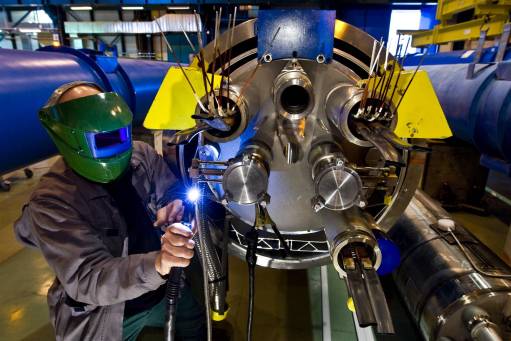
ATLAS e-News
23 February 2011
Update on the LHC
8 December 2008

Preparing the first replacement to enter the tunnel
Since the report released on October 16th, the LHC team has been hard at work, assessing the damage to the accelerator in sector 3-4 and beginning repairs.
Roberto Saban, in charge of hardware commissioning on the LHC, followed ATLAS Spokesperson Peter Jenni in opening the ATLAS Week plenary sessions last Monday.
We already knew that the puncture in the helium vessel in sector 3-4 was caused by an electrical arc in a bus-bar splice between a dipole and a quadrupole. The pressure in the vacuum chamber exceeded that which the barriers could withstand, even with the valves releasing helium into the cavern, and the force of this pressure pushed the magnets against one another, unbolting many of them from the tunnel floor.
The soot from the arc burning through the magnets travelled along the beam pipe. According to Dr Saban, the team is removing 39 dipoles and 14 “Short Straight Sections” (SSSs), which house the quadrupoles and their cryostats. Since the pipe is built into the magnets, the magnet replacements will also replace the beam pipe beyond the contaminated region.
Repairs are already well underway. Twelve dipoles and six SSSs have already been removed, and the first replacement dipole went underground on Saturday, November 29th. Two more were supposed to go underground last week. Twenty of the magnets should be replaced before CERN closes for the winter holidays.
The monitoring system within each magnet kept a strict watch on any potential difference between the two halves of a magnet. Said Dr Saban: “When the difference goes above 100 milliVolts for 10 milliseconds, we decide there is a quench, we fire the heaters, and a diode which is in parallel with the magnet takes over the current.”
However, the monitoring system surveyed the magnets themselves but not the bus-bars. The accelerator team is upgrading the quench detection system to keep an eye on the interconnects as well.
Moreover, they’re adding more valves to release the helium so that even in the event of another electrical arc, the gas won’t achieve such large pressures. In the sectors that will be warmed over the winter – sectors 1-2, 3-4, and 5-6 – the team will install a “blank flange” valve on every dipole and SSS. Only the SSSs will receive these new valves in the cold sectors.
Apart from sector 3-4, the accelerator team has concluded that one dipole in sector 1-2 suffers a resistance of 100 nano-Ohms, and this dipole is to be replaced. They will also replace a bus-bar insulation in sector 5-6.
The last magnet will enter sector 3-4 by the end of March, according to the current schedule. The LHC will be cold by the beginning of July, and the aim is to have beams in the machine end of July. Collisions are planned for late summer. The energies are not likely to exceed 10 TeV in 2009, but a plan-of-action which excluded beam altogether in 2009 has been ruled out. An official report on the LHC repair and schedule was released Friday.

Katie McAlpineATLAS e-News |